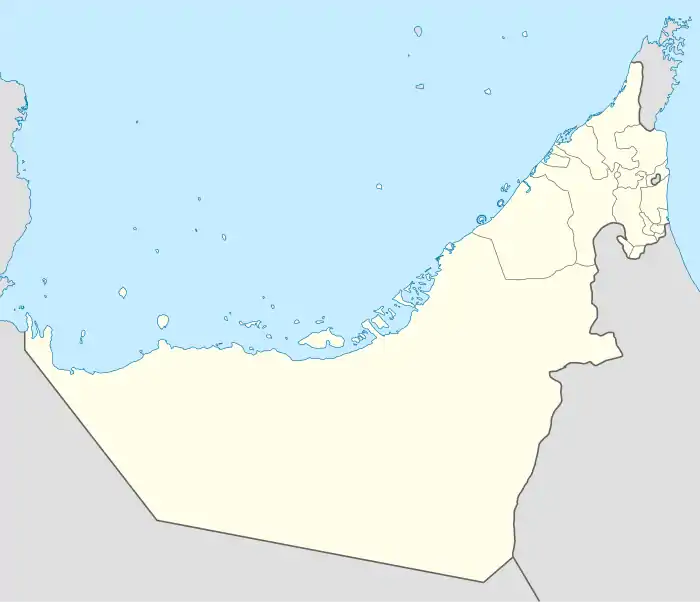Al Jahili Fort
Al-Jahili Fort (Arabic: قَلْعَة ٱلْجَاهِلِي, romanized: Qalʿat al-Jāhilī) is a fort in Al Ain, Abu Dhabi, the United Arab Emirates. The fort was established in 1891 around Al-Jahili Oasis for the protection of palm farmers.[1] Later it was seized by the former Omani coastal scout for its operation to protect the mountain lanes and to preserve the inter-tribal peace.[2] The fort was mentioned and recorded by several historical figures. Percy Cox, in his tour to Al Ain in 1905, reportedly visited the Al Jahili region. In 1906, J. G. Lorimer mentioned that the fort was constructed under the rule of Zayed bin Khalifa Al Nahyan.[3]
| Al-Jahili Fort | |
|---|---|
قَلْعَة ٱلْجَاهِلِي | |
| Al Ain, Eastern Region of the Emirate of Abu Dhabi, the UAE | |
 | |
 Al-Jahili Fort | |
| Coordinates | 24°12′58″N 55°45′9″E |
| Site information | |
| Condition | Restored |
| Site history | |
| Built | C. 1891 |
Location
The fort is located on the southern part of the city of Al Ain close to Al Ain Castle Museum. It is on the strategic location where exist water sources and agricultural land.[1]
Architecture
Similar in appearance to Mezyad Fort,[4] Jahili Fort is one of the largest castles in the city.[1] It is a part of the bigger complex for public activity which includes public square. The fort is square shaped and has a length of 35 metres (115 feet) and height of 8 metres (26 feet). There are embrasures and triangular balconies on the top. It has three round watchtowers, and a rectangular watchtower on the northwestern corner. Round watchtowers have a diameter of 5 metres (16 feet), and a height of 14 metres (46 feet). The rectangular watchtowers has width and length of 4 and 7 metres (13 and 23 feet) respectively, and height of 14 metres (46 feet). The rectangular tower is considered stronger in terms of defensive capacity.[3]
Restoration
The fort was restored by the Department of Antiquity and Museum in Al Ain during the mid-1980s. It was later restored again by the Abu Dhabi Authority for Culture & Heritage in 2007–2008, during which several infrastructures were put in place, including the visitors' office, gift shops, cafe and wider public square for exhibitions and cultural activities. The fort is planned to be rehabilitated in the future for bigger roles in the tourism and social activity in Al Ain region.[5]
Replica
A replica of the fort exists next to Sheikh Zayed Bridge over the Swat River in the Swat Valley of Pakistan. The model, as well as the bridge, were inaugurated in April 2013.[6][7][8]
See also
References
- قلعة الجاهلي في العين وسجل التاريخ الخالد (in Arabic). Al Khaleej. Retrieved January 13, 2018.
- قلعة الجاهلي (in Arabic), Visit Abu Dhabi, retrieved January 13, 2018
- "Archived copy" القلاع والحصون في مدينة العين, Al Ain Region Ruler's Representative Court (in Arabic), archived from the original on December 16, 2017, retrieved January 13, 2018CS1 maint: archived copy as title (link)
- Kazmi, Aftab (2013-05-23). "Mezyad Fort stands tall in the foothills of Jebel Hafeet". Gulf News. Retrieved 2019-03-04.
- قلعة الجاهلي تروي «قصة العين» (in Arabic). Al-Ittihad. Retrieved January 13, 2018.
- "Shaikh Zayed Bin Sultan Al Nahyan Bridge inaugurated in Pakistan". WAM. Gulf News. 2013-04-13. Retrieved 2020-01-03.
- "In pictures: Sheikh Zayed bridge inaugurated in Pakistan". The National. 2013-04-14. Retrieved 2020-01-03.
- Duncan, Gillian (2020-01-02). "UAE-Pakistan ties are as old as the Emirates". The National. Retrieved 2020-01-03.
External links
| Wikimedia Commons has media related to Al Jahili Fort. |
- Al-Jahili Fort, Visit Abu Dhabi